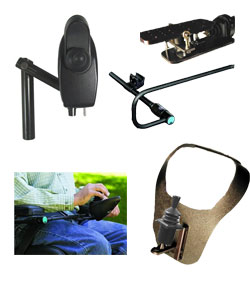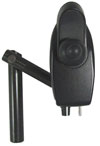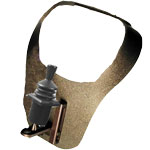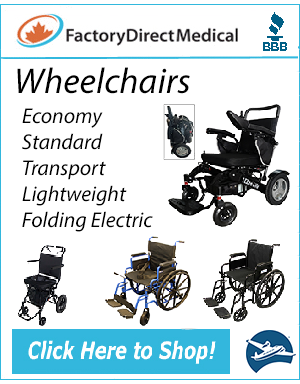
Power Wheelchair Joystick Mounts
Power wheelchair joysticks are the most common components used to drive the wheelchair and they have to be mounted in a position where the user is able to easily and comfortably access them for extended periods of time. A properly positioned joystick will enable the user to drive their power wheelchair more safely and reduce their fatigue over the day.
A standard joystick mount usually consists of a steel or aluminum rod that is clamped to the wheelchair arm and will adjust forward and back depending on the reach of the user. The standard joystick mount is limited in its ability to be positioned higher and lower, further left or right, or swing out of the way.
The information I've provided below refers to the more common optional mounting devices available to answer some issues with the standard mounts.
Swingaway Joystick Mounts

When approaching a desk or table the joystick, that is normally positioned in front of the armrest, will usually hit the table top and prevent the user from getting in close enough to use the table or desk. A swingaway joystick mount allows for the joystick to be moved out of the way so the user can get close enough to be functional.
The best designed swingaway mounts allow the joystick to be positioned back beside the arm pad instead of in front of the armrest while still pointing forward. The older and less functional swingaway mounts swung the joystick away at a 90° angle to the armrest and pointed it sideways.
If the user wanted to move their wheelchair while the joystick is swung away and they have the older 90° style they have to move the joystick gimbal left and right to go forward and back, and forward and back to go left and right. Needless to say the older style was a hazard when used by anyone who may get confused at times.
Midline Joystick Mounts

A midline joystick mount allows the joystick to be mounted anywhere between the arms of the power wheelchair. Some power chair users find it difficult to sit with their hands positioned on the gimbal at the end of the armrests. When a midline mount is used, a compact or small remote joystick is mounted somewhere along the length of an aluminum or steel bar that spans the area between the two wheelchair armrests.
With the elbows supported by the wheelchair armrests and the hands positioned somewhere in front of the user's torso many users are more comfortable and have better control of their hands. When the user is comfortable they will have much more stamina and with better control of their hands they will be safer driving.
Joystick Chin Mounts
Chin mounts are for people who use aren't able to use their hands to drive the power wheelchair. The chin mount is very similar to the midline mount but will often be mounted to the wheelchair back posts rather than the wheelchair armrests. Using the same small remote or compact joystick as the midline mount the joystick gimbal knob is often, but not always, replaced with a small cup-shaped gimbal that the user manipulates with their chin.
Joystick Bib Mounts

A bib mount for a joystick positions the joystick on the user's chest with the gimbal at the chin as an alternative to the conventional chin mounted joystick that is mounted to the wheelchair. Some users find this type of mount less confining than a conventional chin mount system and allows them to change position in the wheelchair while keeping the joystick gimbal within reach.
The bib itself is made of a plastic like material that is joined behind the neck and can be cut and shaped once the joystick has been positioned correctly. a person who uses as bib mount will not likely be able to put it on themselves but once it is set up by a care giver the user is pretty much independent.
Joystick Foot Mount

Foot mounted joysticks are not very common but are an alternative for those who are not able to use their hands, chin or head to drive the wheelchair. The wheelchair joystick is mounted to a footplate that pivots and turns. The user pivots their foot forward and back to drive forward and back or turns theri foot to turn the wheelchair.



 Online Vendors
Online Vendors  US Online Vendors
US Online Vendors 

